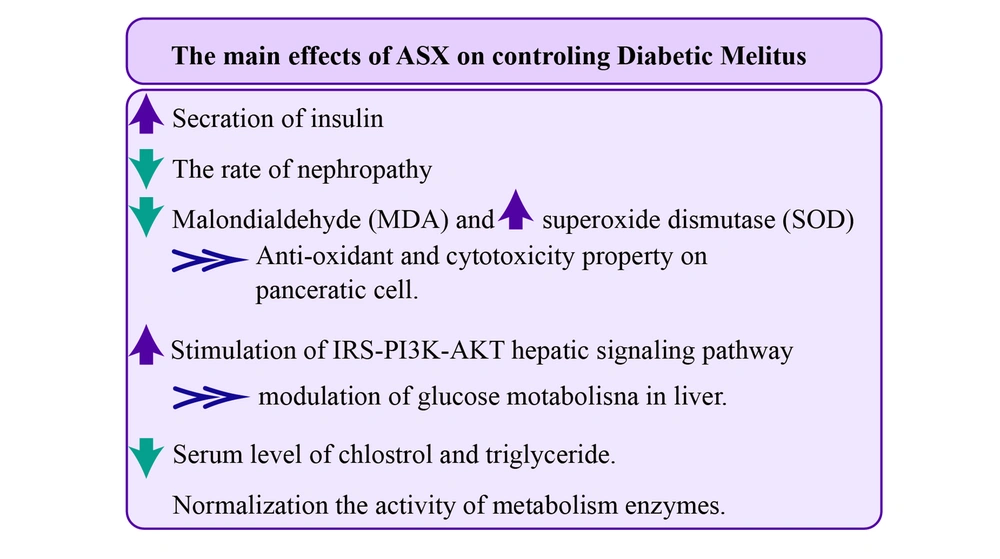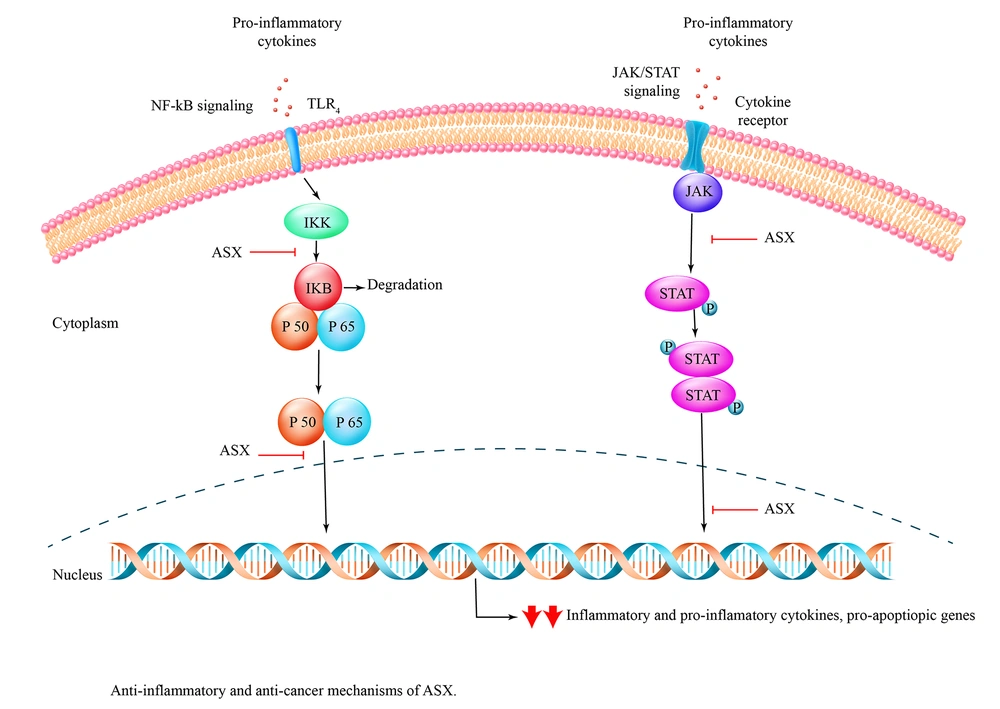Dear Editor,
Astaxanthin (ASX) is a type of carotenoid that is lipid-soluble and belongs to the xanthophyll class. It is produced by a variety of marine animals and microorganisms, including lobsters, shrimps, fungi, bacteria, microalgae, and yeasts. As a bioactive natural compound, ASX has numerous pharmacological effects on human health, including antioxidant, anti-inflammatory, anti-lipid peroxidation, antidiabetic, and anticancer effects. Since humans are unable to synthesize ASX in their bodies, ASX extracted from natural resources can be used as a suitable supplement for humans (1).
Antioxidant Activity
Free radicals contain at least one unpaired electron in their outermost electron shell. Consequently, they seek to stabilize themselves by either taking an electron from or giving one away to other molecules in order to pair their unpaired electrons (2). When there is an excess of oxidative molecules, they can initiate chain reactions with lipids, proteins, and deoxyribonucleic acid (DNA), causing lipid oxidation and DNA damage. This can lead to various disorders, including cancer, cardiovascular disease, autoimmune disease, diabetes mellitus, and hypertension. Generally, ASX has a unique molecular structure that includes keto and hydroxyl moieties on each ionone ring; these moieties account for the significant antioxidant effects of ASX (3).
Moreover, ASX has been shown to have a much higher antioxidant activity than other carotenoids and antioxidants (4). The antioxidant activity of this substance is significantly greater than that of other antioxidants, being 10 times greater than β-carotene, lutein, zeaxanthin, and canthaxanthin and 100 times greater than that of α-tocopherol (5). Additionally, ASX has a unique ability to capture radicals both on the surface and inside the cell membrane, thanks to its end-ring structure; however, its polyene chain can only capture radicals on the cell membrane (6). Astaxanthin has been indicated to have beneficial antioxidant effects in the prevention and treatment of cardiovascular disease, autoimmune disease, mellitus diabetes, and skin hemostasis. (7-11). Moreover, the anti-aging and neuroprotective effects of ASX are attributed to its anti-oxidant properties (12-14).
Cardiovascular Protective Effects
Moreover, ASX can reduce the level of C-reactive protein and lower the level of triglyceride. It has the ability to increase the levels of adiponectin and high-density lipoprotein-cholesterol (HDL-C) in the body (1). According to various studies, ASX inhibits lipid peroxidation in biological samples (5, 15). This is achieved through several mechanisms, including singlet oxygen quenching, radical scavenging for the inhibition of chain reactions, preservation of the membrane structure through the inhibition of lipid peroxidation, improvement of the immune system function, and regulation of gene expression (5).
Anti-inflammatory Activity
Astaxanthin is a potent antioxidant that has been shown to inhibit inflammation in biological systems. It has the ability to regulate the immune response and decrease inflammation related to various peripheral diseases (6). Moreover, it has been shown to have the ability to regulate microglial cells, which play a crucial role in maintaining homeostasis and are involved in the immune response of the central nervous system (CNS). Upon recognizing a threat (e.g., cell damage or the presence of pathogens), these cells secrete pro-inflammatory cytokines, including tumor necrosis factor-alpha (TNF-α), interleukin-6 (IL-6), interleukin-1beta (IL-1β), and nitric oxide (NO) (6, 16). Generally, ASX exerts anti-inflammatory effects on the CNS through several mechanisms. These mechanisms include inhibiting the secretion of pro-inflammatory cytokines, such as IL-6, along with enzymes, including Cox-2 and iNOS/nitric oxide. It can also inhibit the activation of the transcription nuclear factor kappa B (NF-kB) (6). Studies have indicated that ASX has protective effects against inflammation, oxidative stress caused by high glucose levels, and apoptosis in proximal tubular epithelial cells (5).
This molecule shows promise in the treatment of ocular inflammation in the eyes, glaucoma, cataracts, and age-related macular degeneration (1, 17).
Antidiabetic Activity
Moreover, ASX has been shown to reduce the level of oxidative stress due to hyperglycemia in pancreatic β-cells. Additionally, it positively affects the serum glucose and insulin levels (6). It is known that ASX stimulates the IRS-PI3K-AKT signaling pathway by reducing the serine phosphorylation of insulin receptor substrate (IRS) proteins. This, in turn, enhances glucose metabolism through the regulation of the activity of metabolic enzymes (18). It also lowers the serum level of cholesterol and reduces triglyceride levels in the liver while stimulating the expression of antioxidant genes. In addition, ASX has been shown to have several potential antidiabetic effects, which include normalizing the activity of enzymes, such as pyruvate kinase, glucose 6-phosphatase, hexokinase, glycogen phosphorylase, and fructose-1,6-bisphosphatase. It can also prevent cytotoxicity and oxidative stress in pancreatic cells, reduce the activity of serine kinases, and lower the level of malondialdehyde (MDA) (6). The main effects of ASX on diabetes mellitus are shown in Figure 1.
Anticancer Activity
According to several studies, ASX can exert anti-proliferative, anti-apoptotic, and anti-invasive effects through various molecules and pathways, including signal transducer and activator of transcription 3 (STAT3), NF-κB, peroxisome proliferator-activated receptor gamma (PPAR-γ), and other mechanisms that can affect cancer development. Furthermore, ASX is believed to protect body tissues against oxidation and ultraviolet (UV) damage by suppressing the activation of NF-κb (1, 19). Moreover, ASX has been shown to have the ability to prevent the initiation of cancer by protecting DNA against damage caused by UV radiation and oxidants. This is accomplished by promoting the early detection and elimination of cells undergoing malignant transformation while evading detection by the immune system (1, 20). Compared to other carotenoids, such as β-carotene and canthaxanthin, ASX has been found to have a higher antitumor activity. The beneficial effects of ASX against colorectal cancer and breast cancer have been reported in various studies (6). The anticancer and anti-inflammatory effects of ASX are shown in Figure 2.
The safety and appropriate dose of ASX are different in humans and animals. A study determined the no-observed adverse-effect levels (NOAEL) of ASX as 465 and 557 mg/kg/day for male and female rats, respectively. Therefore, ASX in high doses (500 mg/kg/day) had no toxic effects on biochemical biomarkers, including albumin, globulin, creatinine, alkaline phosphatase, alanine, and aspartate aminotransferase in rats (21). Although the studies about the side effects of ASX in humans are limited, a dose of 100 mg of ASX has not shown any adverse effects in humans. The appropriate dose of ASX to achieve the beneficial effects is determined to be 2-4 mg/day in adult human subjects, which can be obtained from ASX natural resources or formulated supplements (5). Currently, ASX nanoparticles are formulated to improve pharmacological effects, such as anticancer activity (22-24).
Finally, paying attention to bioactive natural compounds can be considered an appropriate solution to prevent and treat diseases. However, clinical trials on the efficacy of ASX are limited; therefore, conducting further clinical research on these compounds is suggested.

